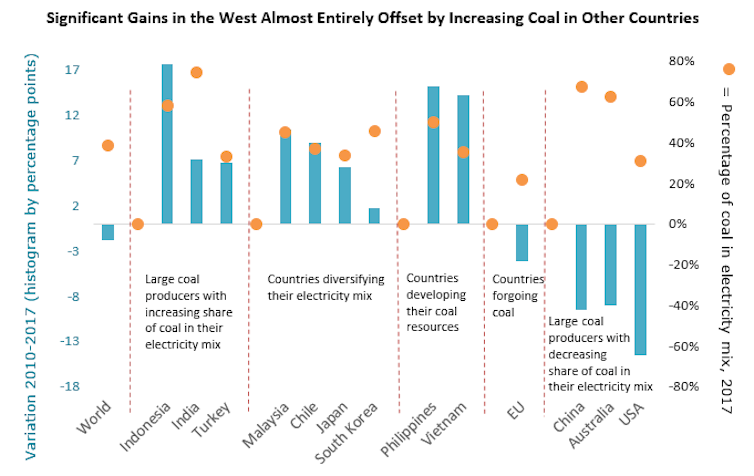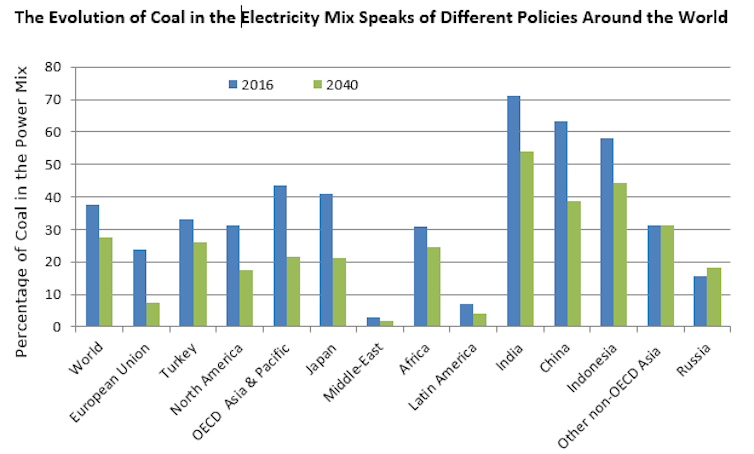Why Does Coal Continue to Grow
Published in December 2018, the recent report of the International Energy Agency (IEA) indicates that global coal consumption is on the rise again (+1% compared to 2017).
This is an alarming trend, because despite increasing international awareness of the risks of global warming due to greenhouse gas emissions, some major economies are unable to substitute their coal-based electricity with less carbon-intensive energies. Indeed, coal is mainly used for electricity production, with two-thirds of world consumption going to electricity production; this proportion rises to three-quarters if China and India, which traditionally have more widespread uses, are excluded; the rest of consumption goes to industry (mainly steel).
Coal remains the most polluting source of energy: it generally emits twice as much CO₂ as natural gas, its main competitor.
How can we explain the increase in coal consumption in this context of climate change? We will rely on the various databases issued by energy consulting company Enerdata to decipher the major global trends.
Coal remains the main energy source to produce electricity
Worldwide, coal consumption for electricity generation is almost growing at the same rate as the electricity consumption (2.8% per year versus 3% per year between 2000 and 2017). As a result, the share of coal in the power mix has almost remained steady for the past 20 years around 40%. Even if it has only decreased by two points since 2010 (see Figure below), coal is still the most widely used energy source for electricity generation in the world.

Closer up, we see opposing trends in the world's largest economies: the efforts and announcements of the majority of countries that are phasing out the use of coal to produce electricity are being undermined by a number of countries that are increasing the share of coal in their power mix.
This is the case particularly for major coal-producing countries such as Indonesia (58% of electricity produced from coal, 18 percentage points increase from 2010 to 2017), Turkey (33%, +7 points) and India (75%, +7 points, as shown in Figure 1, above). India is the second largest coal producer in the world after China with significant coal reserves. The development of renewables and the commissioning of more efficient coal-fired power plants in India are not sufficient to absorb the growth in electricity demand, which has averaged 7% per year since 2005.
Other countries are seeking to diversify their energy mix and are increasingly using coal to produce their electricity: Malaysia (45%, +10 points), Chile (37%, +9 points), South Korea (46%, +2 points) and Japan (33%, +6 points). These countries rely on coal for several reasons: in addition to often being a cheaper source of electricity, coal limits their dependence on oil- and gas-producing countries, and in turn limits the effect of hydrocarbon price volatility on their economies. Due to a lack of domestic fossil fuel resources, Japan is one of the largest oil-, natural gas- and coal-importing countries. Between 2011 and 2015, the share of coal in Japanese electricity production increased significantly to cope with the closure of nuclear power plants following the Fukushima disaster.
Finally, some countries with national coal reserves, such as the Philippines (50%, +15 points) and Vietnam (34%, +14 points), are developing this resource to produce electricity and to improve their energy independence and balance of payment.
Declines in China, the United States and the EU
Conversely, the share of coal in the electricity mix has fallen sharply in most European Union countries, as well as in China and the United States. To fight climate change, EU countries are significantly reducing the use of this fuel (21%, -10 points since 2000). However, coal retains a dominant weight in the power mix of some EU coal producing countries, such as Poland (78%), the Czech Republic (49%) and Germany (39%), although its share in these nations is falling sharply.
China – by far the world's largest coal consumer for electricity generation – is implementing restrictive environmental and energy policies on coal use (68%, -10 points from 2000 to 2017) to improve air quality and to contribute to efforts to fight climate change.
The United States, like China, is a major coal-producing country, and has significantly reduced the importance of coal in its electricity mix (31%, -15 points) but for another reason: the development and abundance of shale gas.
At world level, coal-fired power plant capacity has increased by 1,000 GW since 2000 and by 500 GW since 2010. This increase is mainly due to additions in China (+850 GW since 2000, which is 80% of the global variation) and to a lesser extent India (+150 GW since 2000). The significant decline in the United States and in the European Union (-80 GW total, or very nearly 40 GW each since 2000) was offset by increases in Japan, Korea and Turkey (+70 GW including 40 GW in Japan).
Countries turning newly to coal
What's even more surprising in the context of widespread action to fight climate change is that some 20 countries are turning to coal, including nine in Africa (DRC, Egypt, Ivory Coast, Kenya, Morocco, Mozambican, Niger, Senegal and Tanzania), three in Central America (Panama, Salvador and Dominican Republic), two in the Middle East (UAE and Jordan) and three in Asia (Bangladesh, Cambodia and Myanmar).
By 2025, more than 65 coal-fired power plants could be commissioned in these countries, representing a capacity of 50 GW (equivalent to more than 2% compared to global capacity in 2017). Most of these countries do not even have coal resources, with the exceptions of Bangladesh and Tanzania. Most often, they develop their projects with Indian or Chinese funding since the major international funding agencies no longer support this type of project. One example is the megaproject Lamu coal-fired power plant, built by China Power Global, with the support of the African Development Bank in Kenya.
And in the longer run?
The projections of EnerFuture forecasts are moderately optimistic, as by 2040 the share of coal in the world power mix is expected to decrease by only 10 percentage points in the EnerBlue scenario (in which global demand increases, but demand and CO2 emissions are contained within the objectives of the Paris Agreement) (see Figure below). In line with the announcements of the "Clean Energy for All Europeans" package, the European Union, which aims for carbon neutrality by 2050, is on the right track despite Poland's reluctance to stop subsidizing its coal-fired power plants beyond 2030. China, India and Indonesia – where electricity is produced primarily from coal – will significantly reduce the share of coal in their power mix, but not below 35%, due to the abundance of domestic coal reserves and their economic attractiveness.

With a steady electrification increase, driven by the development of some emerging economies and the diffusion of new electric end uses (such as e-mobility), electricity demand will continue to increase in the short and medium term.
If the largest countries in the world do not put in place the solutions to substitute coal with "greener" energy, it will be exceedingly difficult to keep global warming within acceptable levels.
The challenge that remains is mainly concentrated with countries that are both large producers and consumers, such as China and India, which are trying to reduce their dependence on this mineral. But the question remains whether these efforts will be sufficient, particularly in view of the enthusiasm for coal (abundant, easy to transport and cheap) in countries currently introducing coal power generation, like in Bangladesh, or in view of the implementation of plans promoting the development of this fossil energy, as in the United States where coal reserves are substantial?
Bruno Lapillonne, scientific director of Enerdata, an energy intelligence and consulting company, coauthored this article.
Source: https://theconversation.com/explaining-the-increase-in-coal-consumption-worldwide-111045
0 Response to "Why Does Coal Continue to Grow"
Postar um comentário